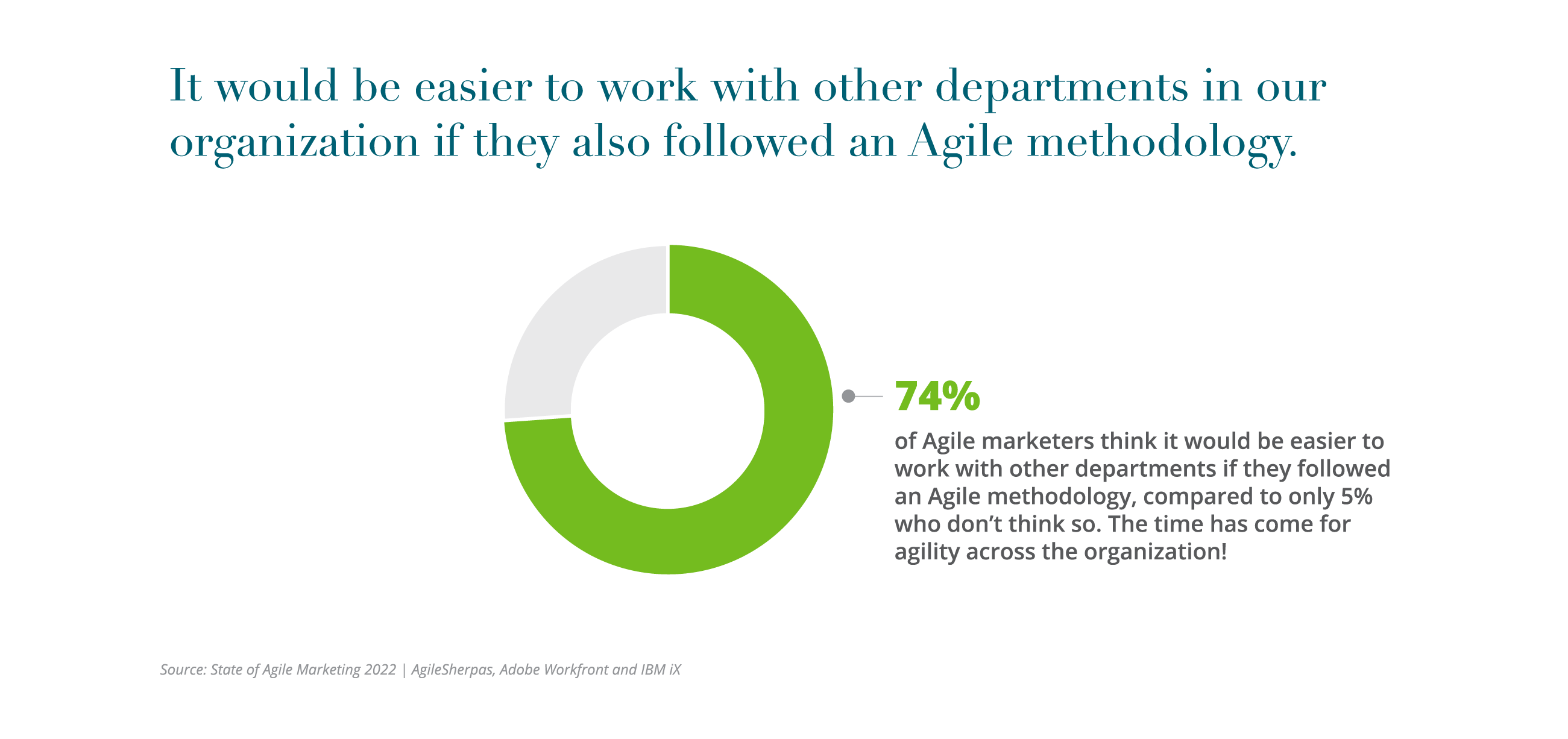Most of us marketers have experienced it at some point. You know your work is absolutely critical for the organization but you have to deal with other departments which think they can handle marketing as well as you can. It’s deeply frustrating but also bad for the entire organization.
If marketing and your organization as a whole are each going to thrive, you need to ensure stakeholders understand the value you bring. However, the first step is to ensure you’re contributing as much value as possible before working out how to demonstrate that contribution to a wider circle. Fortunately, there are ways to maximize your marketing impact while simultaneously making that impact clearer than ever to leadership.
Below, we’ll briefly go through how you should be maximizing the effectiveness of your marketing and then how to sell that effectiveness and champion marketing across the organization.
Start with Maximizing Your Impact with Agile Marketing
The single most important factor in proving the value of marketing is having extremely effective marketing to begin with. Getting there starts with Agile.
This is because Agile marketing is built around a focus on delivering value to stakeholders, iterating frequently to improve processes, and empowering everyone on the team with more visibility. This way, marketers can plan, work, and improve everything they do far more effectively.
Agile marketers are 50% more likely to say they’re satisfied with the way their department manages its work compared to traditional marketers. That jumps to nearly 75% if you compare them with Ad hoc marketers. Agile marketers also feel more confident in their effectiveness, with a staggering 92% of Agile teams saying they’re confident they can tackle any unplanned work in remote or in-person conditions.

A confident marketing team will be better able to make a strong case for that its value to the rest of the organization. That’s why marketing agility is a key foundation for demonstrating effectiveness.
Budgeting and ROI are Key Tools
The most common way you’re going to demonstrate how your marketing team contributes to the overall success of the organization is through calculating return on investment (ROI) for marketing activities. While the end goal of every marketing team is different, the input (resources, usually money and time) is relatively consistent. So how can you improve that calculation when presenting to leadership?
You can start by moving from big expensive campaigns to smaller ones focused on experimenting, testing, and using Minimum Viable Products (MVPs). Then, only invest large amounts of resources into a particular campaign or strategy once you have solid evidence that it will produce the value you need.
This is a key difference between Agile marketers and everyone else. Traditional and ad hoc marketers tend to go all-in on “big bang” campaigns, producing far more risk.
Another major difference comes in how Agile approaches budgeting. Most marketing teams that adopt Agile also change how they budget, shifting from annual budgeting to semi-annual, quarterly, or even dynamic budgeting.
Not only does this make marketing more nimble, it gives the department more opportunities to present updates on budgetary effectiveness and ROI. Because Agile marketing focuses on tracking value delivered, it will equip you to more easily demonstrate what you’ve accomplished for the budget allotted. Regular updates on real value delivered will make a strong case for your leadership team.
Making Your Case with the Right Data and Framing
Tracking value delivered is easy to get behind but far more difficult to calculate in most marketing departments, so how can you effectively show your value with data? This is going to vary depending on the type of marketing you do, though Hubspot has an excellent universal breakdown.
What’s most important is identifying the right leading and lagging indicators to collect and to begin that collection as soon as you launch the first parts of a campaign. That's the easier part because it's within our control. Packaging that data in a way that makes sense to adjacent teams is another challenge to consider.
Start by understanding their priorities. What does your organization want to achieve in the short, medium, and long term? Clearly demonstrating how the accomplishments of marketing are contributing to those goals is the most efficient way to demonstrate your department’s value.
For example, let’s say your organization is trying to increase its lead quality. Ideally, you’re working as an Agile team and will be able to focus your marketing efforts around this goal within a few weeks at most. You can begin by working with sales to define current and desired lead quality, then start experimenting with various customer-centric strategies to improve that quality.
By running these kinds of controlled experiments, even if you are unable to improve that metric in the short-run, you can clearly demonstrate your data-driven approach and the lessons learned in the process to leadership. So, instead of simply coming to them with “we tried X and it didn’t work,” you can present your hypothesis, the tests you did, and what you concluded from the results.
With Agile marketing, you’re then able to pivot by applying those lessons to your next sprint. So from the leadership’s perspective, you’re quickly and nimbly moving to find a solution to their most pressing problems.

Demonstrate Value Through Other Departments
The additional efficiency of Agile marketing also enables the department to spend more resources assisting others within the organization. For example, marketing can create a customer survey to help Product developers identify areas to improve. Or, this might simply be using more effective marketing methods to supply Sales with more high-quality leads.
In either case, you’re turning fellow departments into their own independent advocates for marketing. If marketing can make itself a consistent source of value to a variety of departments, it’s far easier for the organization as a whole to view greater support for marketing as a win for everyone.
Organizational Agility Compounds the Benefits of Agile
Clearly, an Agile marketing department is well-positioned to show how it’s contributing to an organization’s success, but there are additional steps that you personally can take to compound the benefits of Agile for the organization. One critical step is to advocate for organizational agility.
Organizational agility is fast becoming a hot topic in the marketing world for good reason. Marketers are well-placed to be a conduit for Agile ways of working across the organization because they stand a lot to gain from this as well.
74% of Agile marketers think it would be easier to work with other departments if they followed an Agile methodology, compared to only 5% who don’t think so. Organizations that embrace agility simply perform better.

That’s because organizational agility is built on the same principles as marketing agility is: focusing on stakeholder value, using quick iterative cycles to improve, generally eliminating waste and adapting to fast-changing business environments.
Of course, you’re not likely to be in a position to argue for a full-blown organizational overhaul from the start. That’s why it’s best to begin that process by showing the success you’ve had in marketing and proposing other pilots in other departments.
Each additional department that embraces agility is another department with which marketing can work more effectively. Thus, the benefits of Agile compound and you have even more positive results to show leadership.
Showing Your Value Begins with Arming Yourself with Up-to-Date, Reliable Data Points
Whether you’re looking to begin by transitioning to Agile marketing or just generally want a better way to demonstrate the value marketing provides, everything begins with good information. That’s one of the reasons we’ve been conducting a massive research study on the State of Agile Marketing annually for the past five years.
In it, you’ll find 29 pages of data, analysis, and helpful tips on how to be a more effective marketer and contribute to a more effective overall organization.